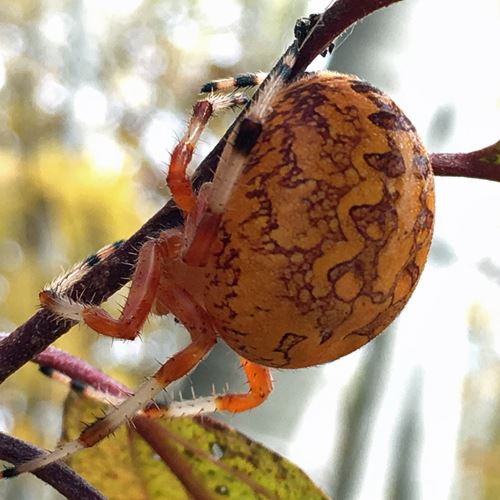The Pumpkin Spider

By Karen Menard
A graceful orb suspended on a single, transparent strand of silk slowly lowers itself from a forest treetop, dangling in the breeze. At last, this bright orange bauble of an invertebrate complete with striped appendages at its sides, makes its grand fall appearance!
It's the marbled orb weaver (Araneus marmoreus), also known as “the pumpkin spider.”
The name originates from its large, orange abdomen’s resemblance to a fat pumpkin. By October, this arachnid has reached its portly size after feasting on insects all summer long.
Remember Charlotte’s web? Charlotte was an orb weaver that crafted a large, beautiful web. Female spiders like Charlotte are generally larger in size than males and are more noticeable as they sit and wait in their wheel-shaped snares for their next meal to arrive.
Orb weaver spiders are engineering masters of webs carefully crafted of sticky and nonsticky strands of silk. They are able to use their third claw to traverse the nonsticky parts of the web. The unlucky prey that finds itself glued to the sticky capture silk is paralyzed by a bite and then quickly wrapped up tight. As the spider begins to eat, digestive fluid is released upon its prize, liquefying the insect meat, making it easier to digest.
Marbled orb weavers are beautiful animals which are non-venomous and are not considered a risk to humans. Docile and non-aggressive, they often scurry away quickly from any potential threats. As beneficial predators, they are able to successfully seize many insect pests.
As you walk the trails into November, see if you can spot a small orange glow swaying from a tree branch or sauntering across the trail.
Did You Know?
Marbled orb weavers create a new web every day during the late afternoon and evening hours.
-
Photo: Female marbled orb weaver at Fallen Timbers Battlefield, by Karen Menard